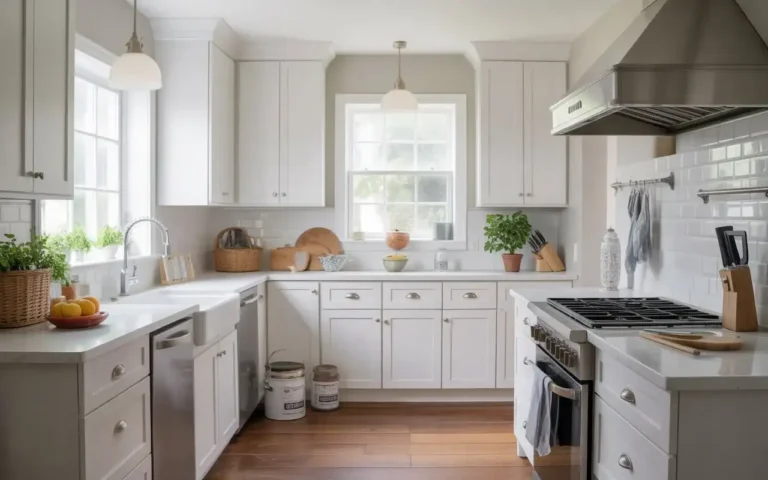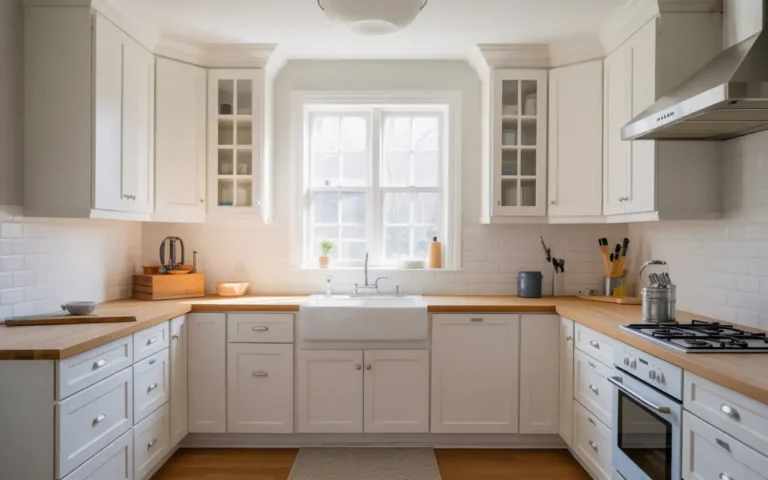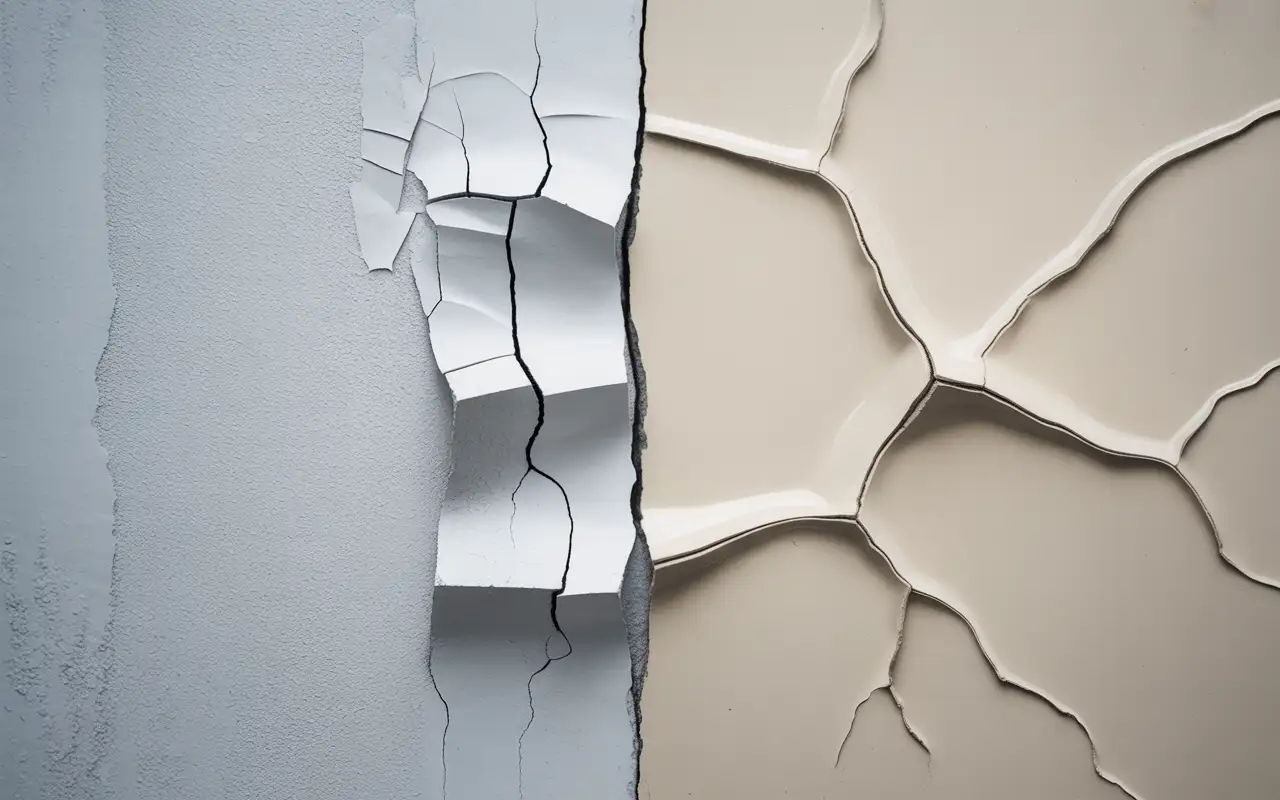Painting kitchen cabinets can save you thousands compared to replacement while giving your kitchen a fresh look. After painting over 500 kitchens in San Diego, we’ve seen every mistake and success. This guide shows you how to paint kitchen cabinets the right way, avoiding the common failures that ruin most DIY jobs within the first year.
The process takes 3-5 days for a typical kitchen. You’ll need proper prep work, quality paint, and patience between coats. Skip any step, and you’ll face peeling, chipping, or a sticky finish that never fully cures.
Table of Contents
ToggleHow Much Does it Cost to Paint Kitchen Cabinets?

The real cost depends on whether you DIY or hire professionals.
DIY Cost Breakdown:
- Paint and primer: $100-$200
- Sandpaper and supplies: $50-$75
- Brushes and rollers: $30-$60
- Deglosser and cleaners: $20-$40
- Total: $200-$375
Professional Cost in San Diego:
- Small kitchen (10-15 cabinets): $2,500-$4,000
- Medium kitchen (16-25 cabinets): $4,000-$6,500
- Large kitchen (26+ cabinets): $6,500-$10,000
The price includes labor, materials, and often a warranty. Compare this to cabinet replacement at $8,000-$25,000, and painting becomes the smart choice for cabinets in good shape.
Hidden costs many forget:
- Time off work (2-5 days for DIY)
- Kitchen downtime (you can’t cook)
- Rental equipment for spray painting ($50-$100/day)
- Fixing mistakes (happens more than you think)
Should I Paint My Cabinets?
Not every cabinet deserves paint. Some need replacement.
Paint your cabinets if:
- Solid wood or quality plywood construction
- Doors and drawer fronts are sturdy
- Hinges hold tight without sagging
- No water damage or rot
- You like the current layout
Replace instead if:
- Particleboard is swollen or crumbling
- Veneer is peeling off
- Cabinet boxes are falling apart
- Hinges pull out when opened
- Shelves sag under normal weight
We’ve seen homeowners waste money painting cheap cabinets that fail six months later. If your cabinets shake when you close them, paint won’t fix structural problems.
Material Considerations:
Solid wood cabinets take paint beautifully. The paint bonds well and lasts 5-7 years with proper prep.
Laminate cabinets need a special primer. Regular primers won’t stick. You must use a bonding primer made for slick surfaces. Even then, laminate paint jobs chip more easily than wood.
MDF cabinets paint well but soak up moisture. Any water exposure causes swelling. Use multiple thin coats and keep them dry.
What Type of Paint Do I Need for Cabinets?
The type of paint determines how your cabinets hold up.
Best Paint Types:
- Oil-based paint creates the hardest finish. It levels smoothly and resists chips better than other options. The downside? Strong fumes, slow drying (24 hours between coats), and cleanup requires mineral spirits.
- Acrylic latex paint dries faster and cleans up with water. Modern formulas rival oil-based durability. Look for 100% acrylic formulation, not vinyl acrylic. The cure time takes 2-3 weeks, so handle doors gently during this period.
- Hybrid alkyd paint combines the best of both. It’s water-based but cures hard like oil paint. Benjamin Moore Advance is the most popular choice among pros. It flows smoothly and creates a furniture-like finish.
Sheen Selection:
Semi-gloss finish is most popular for kitchen cabinets. It’s easy to clean and shows fewer fingerprints than high gloss.
Satin finish offers a softer look but shows grease more easily.
High gloss creates a modern, dramatic look but highlights every imperfection. Your prep work must be perfect.
Primer Choice Matters:
Use stain-blocking primer if your cabinets have dark stains, knots, or you’re going from dark to light colors. Regular primer lets tannins bleed through.
Bonding primer is required for laminate or previously painted cabinets with glossy finishes. It grips slick surfaces that regular primers can’t.
Oil-based primer works under any topcoat and blocks stains best. The smell is strong, but the results are worth it.
Essential Tools & Supplies
Quality tools make the difference between a professional look and obvious brush marks.
Must-Have Tools:
Paint brushes:
- 2.5-inch angled brush for detailed work
- 3-4 inch flat brush for large surfaces
- Synthetic bristles for latex paint
- Natural bristles for oil-based paint
Rollers:
- 4-inch microfiber roller for flat surfaces
- Foam rollers for ultra-smooth finish on doors
Sanding supplies:
- 100-150 grit sandpaper for initial sanding
- 220 grit sandpaper between coats
- Sanding block for even pressure
- Electric sander for large flat areas (optional)
Prep materials:
- Liquid deglosser (TSP substitute)
- Tack cloth for dust removal
- Painter’s tape (FrogTape works best)
- Drop cloths
- Screwdrivers for hardware removal
- Plastic containers for organizing screws
Smart Setup Tips:
Number every door and drawer with painter’s tape. Write the number where hinges hide it. This saves hours during reinstallation.
Create a drying station using sawhorses and 2x4s. Screw eye hooks into door edges to hang them while paint dries. This lets you paint both sides efficiently.
Set up in a garage or spare room with good ventilation. Dust and debris ruin wet paint.
How to Paint Kitchen Cabinets in 9 Simple Steps

Step 1: Empty and Prep the Kitchen
Remove everything from cabinets and countertops. Cover counters with rosin paper taped down securely. Tape plastic sheeting over appliances and backsplash.
This protects against dust from sanding and accidental paint splatters. Even careful painters make mistakes.
Step 2: Remove All Hardware and Doors
Take off cabinet doors, drawer fronts, and all hardware. Remove hinges completely. Save the screws in labeled bags.
Number each piece with tape on the back. Start at the top left, work across, then move down. This system prevents confusion during reinstallation.
Pull out drawers and remove the fronts if possible. Some are screwed from inside, others are glued. Don’t force glued fronts.
Step 3: Clean Everything Thoroughly
Grease and grime stop paint from sticking. Use a deglosser or TSP solution to cut through buildup. Kitchen cabinets collect more grease than you realize.
Wipe down every surface with a clean cloth and deglosser. Hold a rag underneath to catch drips. Work in sections and wipe residue away before it dries.
Let everything dry completely. Moisture under paint causes adhesion failure.
Step 4: Sand All Surfaces
Sanding creates texture for the primer to grip. Don’t skip this step.
Use 100-150 grit sandpaper on all surfaces. You’re not removing the old finish, just roughing it up. Sand with the grain on flat surfaces. Use a sanding block for even pressure.
Vacuum everything when done. Then wipe with a tack cloth. Any dust left behind creates bumps in your finish.
Common Sanding Mistakes:
- Sanding too hard removes the old finish completely. This isn’t necessary and wastes time.
- Missing inside edges and corners. These smooth spots reject primer.
- Not cleaning dust properly. Tack cloth is essential, not optional.
Step 5: Apply Primer to Cabinet Frames
Start with cabinet frames still mounted. Primer seals the surface and improves paint adhesion.
Pour primer into a paint tray. Load your brush and roller. Use the brush for edges and tight spots. Roll flat surfaces for faster coverage.
Brush in the direction of the wood grain. This is called “tipping off” and it eliminates brush marks. Overlap each stroke slightly.
Let the primer dry completely. Check the can for exact timing, usually 1-2 hours for latex, 4-6 hours for oil-based.
Step 6: Sand Between Coats
After the primer dries, sand lightly with 220 grit sandpaper. This step seems tedious but it’s critical for a smooth finish.
Feel the surface with your hand. It should be glass-smooth. Any bumps or rough spots will show through paint.
Vacuum again. Wipe with tack cloth. Yes, again. Dust is your enemy.
If you see bare spots where sandpaper cut through primer, spot-prime those areas. Let them dry before continuing.
Step 7: Apply First Coat of Paint
Finally, the fun part. Open windows for ventilation even with low-VOC paint.
Use the same technique as primer. Brush edges first, then roll or brush flat surfaces. Keep a wet edge to avoid lap marks.
For cabinet doors on sawhorses:
Paint the detailed areas first. On panel doors, do the panel inset before the frame. Then paint the frame rails and stiles.
Thin coats are better than thick ones. Heavy coats sag and drip. Two thin coats of paint beat one thick coat every time.
Step 8: Sand and Apply Second Coat
After the first coat dries (check the paint can timing), sand again with 220 grit. This coat should be perfect, so take your time.
Wipe away dust. Apply the second coat of primer using the same careful technique.
Most kitchens need two coats of paint. Dark colors going over light might need three. White over dark definitely needs three coats for solid coverage.
Step 9: Let Paint Cure Before Reassembly
This is where most DIY jobs fail. Paint feels dry after a few hours, but it’s not cured.
Wait at least 24 hours before handling doors gently. For full hardness, wait 3-5 days. Some paints need a full week to cure completely.
Reassemble carefully. Install hinges and hardware. Hang doors in their original locations using your numbering system.
Don’t slam doors or put heavy items on shelves for the first week. The paint needs time to harden completely.
Common Mistakes That Ruin Cabinet Paint Jobs
After seeing hundreds of failed DIY projects, these mistakes appear repeatedly:
- Skipping the deglosser. Paint won’t stick to grease and old finish without proper prep.
- Not sanding between coats. This creates a bumpy, unprofessional finish.
- Using cheap paint. Budget paint chips and yellows quickly in kitchens.
- Painting in humid weather. Paint stays tacky and attracts dust. Wait for dry conditions.
- Rushing the cure time. Doors stick together if installed too soon.
- Wrong primer for the surface. Regular primer fails on laminate or glossy finishes.
- Painting doors flat instead of vertical. Dust settles on horizontal surfaces. Hanging doors dry cleaner.
When to Hire Professionals vs DIY
DIY makes sense if:
- You have 4-6 full days available
- Your kitchen is small (under 15 cabinets)
- You’re comfortable with detail work
- You have proper space to work
- You’re patient and meticulous
Hire pros if:
- You want a sprayed finish
- Your kitchen is large
- Cabinets have intricate details
- You can’t be without a kitchen for days
- You want a warranty on the work
- Time is worth more than money saved
Professional spray finishes look better than brushed. The equipment costs thousands and requires skill. Most homeowners get better results hiring experienced painters for this reason alone.
Final Thoughts
Painting kitchen cabinets transforms your space for a fraction of replacement costs. The process demands patience and attention to detail, but the results last 5-7 years with proper care.
Success depends on three things: thorough prep work, quality materials, and patience during cure time. Rush any step and you’ll see failures within months.
If you’re in San Diego and want professional results without the DIY hassle, San Diego Home Remodeling offers expert cabinet painting services in San Diego with a satisfaction guarantee. Our team has refined the process through years of experience, delivering durable finishes that stand up to daily kitchen use.
Ready to transform your kitchen? Contact us today for a free estimate and see how professional cabinet painting can give your kitchen the refresh it deserves.
Frequently Asked Questions
What grit to sand cabinets before painting?
Use 100-150 grit sandpaper for the initial surface preparation, followed by 220 grit to smooth the primer, and 320-400 grit for light sanding block scuffing between paint coats.
Is oil based paint or latex paint better for cabinets?
Modern waterborne alkyd paint (like Benjamin Moore Advance) is generally superior. It provides the hardness and durability of oil based paint while being less prone to yellowing and offering easier cleanup than traditional oil.
Can I skip sanding my cabinet doors?
You should never skip sanding entirely. Even if you use a bonding primer designed for adhesion (which helps with painting cabinets without sanding), a light scuff sand with 150-grit paper ensures the primer has the best possible physical “key” to bond to, dramatically improving long-term durability.
What is the best type of paint for kitchen cabinets?
A premium cabinet enamel (specifically a waterborne alkyd) in a Semi-Gloss or Satin sheen is the best type of paint. These products are formulated to dry hard, resist blocking (sticking), and offer superior moisture and abrasion resistance.
How long does a painted cabinet job last?
A properly executed cabinet painting job using premium primer and enamel, with thorough preparation, should last 10 to 15 years before needing a refresh. The key to longevity is meticulous surface cleaning and allowing for a full 30-day full cure.





